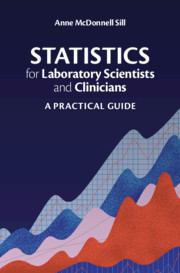Refine search
Actions for selected content:
52379 results in Statistics and Probability
BOOTSTRAP INFERENCE FOR MULTIPLE CHANGE-POINTS IN TIME SERIES
-
- Journal:
- Econometric Theory / Volume 38 / Issue 4 / August 2022
- Published online by Cambridge University Press:
- 25 June 2021, pp. 752-792
-
- Article
- Export citation
SARS-CoV-2 outbreak in a synagogue community: longevity and strength of anti-SARS-CoV-2 IgG responses
-
- Journal:
- Epidemiology & Infection / Volume 149 / 2021
- Published online by Cambridge University Press:
- 24 June 2021, e153
-
- Article
-
- You have access
- Open access
- HTML
- Export citation
The French official statistics strategy: Combining signaling data from various mobile network operators for documenting COVID-19 crisis effects on population movements and economic outlook
-
- Journal:
- Data & Policy / Volume 3 / 2021
- Published online by Cambridge University Press:
- 24 June 2021, e10
-
- Article
-
- You have access
- Open access
- HTML
- Export citation
Detection and viral RNA shedding of SARS-CoV-2 in respiratory specimens relative to symptom onset among COVID-19 patients in Bavaria, Germany
-
- Journal:
- Epidemiology & Infection / Volume 149 / 2021
- Published online by Cambridge University Press:
- 23 June 2021, e150
-
- Article
-
- You have access
- Open access
- HTML
- Export citation
Analysis of call detail records to inform the COVID-19 response in Ghana—opportunities and challenges
-
- Journal:
- Data & Policy / Volume 3 / 2021
- Published online by Cambridge University Press:
- 23 June 2021, e11
-
- Article
-
- You have access
- Open access
- HTML
- Export citation
PES volume 35 issue 3 Cover and Front matter
-
- Journal:
- Probability in the Engineering and Informational Sciences / Volume 35 / Issue 3 / July 2021
- Published online by Cambridge University Press:
- 23 June 2021, pp. f1-f2
-
- Article
-
- You have access
- Export citation
Bridging the gaps in test interpretation of SARS-CoV-2 through Bayesian network modelling
-
- Journal:
- Epidemiology & Infection / Volume 149 / 2021
- Published online by Cambridge University Press:
- 23 June 2021, e166
-
- Article
-
- You have access
- Open access
- HTML
- Export citation
PES volume 35 issue 3 Cover and Back matter
-
- Journal:
- Probability in the Engineering and Informational Sciences / Volume 35 / Issue 3 / July 2021
- Published online by Cambridge University Press:
- 23 June 2021, pp. b1-b2
-
- Article
-
- You have access
- Export citation
Enhanced melioidosis surveillance in patients attending four tertiary hospitals in Yangon, Myanmar
-
- Journal:
- Epidemiology & Infection / Volume 149 / 2021
- Published online by Cambridge University Press:
- 22 June 2021, e154
-
- Article
-
- You have access
- Open access
- HTML
- Export citation
An experimental study measuring human annotator categorization agreement on commonsense sentences
-
- Journal:
- Experimental Results / Volume 2 / 2021
- Published online by Cambridge University Press:
- 18 June 2021, e19
-
- Article
-
- You have access
- Open access
- HTML
- Export citation
On convex holes in d-dimensional point sets
- Part of
-
- Journal:
- Combinatorics, Probability and Computing / Volume 31 / Issue 1 / January 2022
- Published online by Cambridge University Press:
- 18 June 2021, pp. 101-108
-
- Article
- Export citation
Clustered 3-colouring graphs of bounded degree
- Part of
-
- Journal:
- Combinatorics, Probability and Computing / Volume 31 / Issue 1 / January 2022
- Published online by Cambridge University Press:
- 18 June 2021, pp. 123-135
-
- Article
- Export citation

Statistics for Laboratory Scientists and Clinicians
- A Practical Guide
-
- Published online:
- 17 June 2021
- Print publication:
- 08 July 2021
6 - Range and Support of a Measure
-
- Book:
- Counterexamples in Measure and Integration
- Published online:
- 27 May 2021
- Print publication:
- 17 June 2021, pp 123-137
-
- Chapter
- Export citation
12 - Convergence Theorems
-
- Book:
- Counterexamples in Measure and Integration
- Published online:
- 27 May 2021
- Print publication:
- 17 June 2021, pp 235-246
-
- Chapter
- Export citation
Index
-
- Book:
- Computer Age Statistical Inference, Student Edition
- Published online:
- 26 October 2021
- Print publication:
- 17 June 2021, pp 483-492
-
- Chapter
- Export citation
17 - Random Forests and Boosting
- from Part III - Twenty-First-Century Topics
-
- Book:
- Computer Age Statistical Inference, Student Edition
- Published online:
- 26 October 2021
- Print publication:
- 17 June 2021, pp 335-362
-
- Chapter
- Export citation
14 - Integration and Differentiation
-
- Book:
- Counterexamples in Measure and Integration
- Published online:
- 27 May 2021
- Print publication:
- 17 June 2021, pp 261-279
-
- Chapter
- Export citation
User’s Guide
-
- Book:
- Counterexamples in Measure and Integration
- Published online:
- 27 May 2021
- Print publication:
- 17 June 2021, pp xxv-xxvii
-
- Chapter
- Export citation
11 - Modes of Convergence
-
- Book:
- Counterexamples in Measure and Integration
- Published online:
- 27 May 2021
- Print publication:
- 17 June 2021, pp 221-234
-
- Chapter
- Export citation














